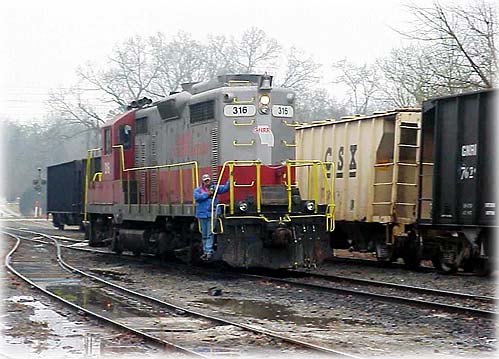 By Bob Ciminel March 28, 2007
But, getting back to the Blue Ridge Scenic, this is the start of the railroad's 10th season, as well as my 10th year as a conductor. However, I work as a brakeman most of the time. I find that stubborn locomotives or cranky engineers are easier to deal with than 400 impatient passengers. Besides, a conductor is really just a brakeman who can read and write. In fact, the definition of a conductor is "a brakeman displaying pencils."  Photograph by Bob Ciminel
I work at a desk and punch computer keys when I'm not on the road, so I enjoy the opportunity to work in the dirty, oily, greasy, smelly, noisy environment of the train. I may come home hot, tired, and dirty, but never frustrated. Like they say, a bad day on a train beats a good day in the office. In the end, both conductors and brakemen do their own small part to make our passengers safe and comfortable. If the conductor forgets to punch your child's ticket as a souvenir, you might be upset, but if the toilets overflow, you will be really mad. The Blue Ridge Scenic Railway is a subsidiary of the Georgia Northeastern Railroad and operates on 13 miles of GNRR track in the North Georgia Mountains, which are also the East Tennessee Mountains or the Western North Carolina Mountains depending on your perspective. The BRSRy route runs from Blue Ridge, Georgia to McCaysville, Georgia along the banks of the Toccoa River. The BRSRy's depot is in Blue Ridge, about 90 miles due north of Atlanta. The fact that there is a four-lane highway the entire way makes Metro Atlanta a lucrative market for a tourist railroad. So, you might ask, "What does a brakeman do?" Well, the first thing we do is start up the locomotive for the engineer, who spent so much time sitting on his derriere in the engineer's seat that he forgot how to do it. Unlike your car, there is no ignition switch on the ancient (1950 generation) diesel locomotives we use on the BRSRy. These are 16-cylinder behemoths that need 600 volts of DC current to crank them over. The first thing we do is close the large knife switch in the rear of the locomotive cab that connects the batteries to the electrical system. Then we go along both sides of the locomotive and open the doors that provide access to the cylinder cocks. These are small valves on each cylinder that are used to detect the presence of water. I'll explain that later. While moving around the engine, we also check the oil level just like you do on a car by reading a dipstick. The oil is pitch black from the carbon that the piston rings scrape off the cylinders. Once the cylinder cocks are open, we turn the Start switch and allow the engine to turn over while watching for any signs of water blowing out of the cylinder cocks. (Diesel engines don't run well on water. Water is not compressible and pistons and cylinders will self-destruct if water gets in them.) We then go around and close the cylinder cocks. If you forget one, you'll know it soon enough. We run the fuel pump for a few seconds to prime the fuel lines and then crank the engine again. A diesel locomotive engine does not start like an automobile engine, it sort of slowly rumbles into life, belching a lot of smoke (and sometimes oil and carbon) out the exhaust stacks. At this point, if you hear the sound of a shotgun going off, you've probably left a cylinder cock open. It's easy to spot; it's the one with fire and smoke coming out of it. Once the engine builds up oil
pressure, which can take almost a minute, the governor takes
control and the engine is ready to run. We then go back into
the locomotive cab and put some fresh flowers and potpourri on
the engineer's control stand, fix him a fresh cup of gourmet
coffee, lay a newspaper opened to the society page on his seat,
turn on the headlight, check the air pressure, and call the engineer
on the radio to tell him his locomotive is ready. If you do
a good job, he might let you blow the horn. On the Web:
He assumes informed readers will be able to tell the difference. Bob lives in Roswell, Georgia, and works for the Institute of Nuclear Power Operations. He is also a conductor on the Blue Ridge Scenic Railway. Contact Bob at ciminel@sitnews.us
|